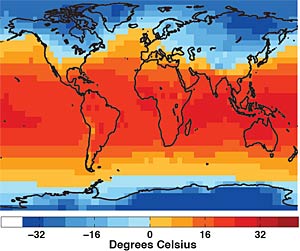To save our grandchildren as well..
http://www.livescience.com/environment/090121-antarctica-warming.html#comments
Antarctica Is Warming:
Climate Picture Clears Up
By Andrea Thompson, Senior Writer
posted: 21 January 2009 01:04 pm ET

- This illustration depicts the warming that scientists have determined has occurred in West Antarctica during the last 50 years, with the dark red showing the area that has warmed the most. Credit: NASA
The frozen desert interior of Antarctica was thought to be the lone holdout resisting the man-made warming affecting the rest of the globe, with some areas even showing signs of cooling.
Some global warming contrarians liked to point to inner Antarctica as a counter-example. But climate researchers have now turned this notion on its head, with the first study to show that the entire continent is warming, and has been for the past 50 years.
“Antarctica is warming, and it’s warming at the same rate as the rest of the planet,” said study co-author Michael Mann of Penn State University.
This finding, detailed in the Jan. 21 issue of the journal Nature, has implications for estimating ice melt and sea level rise from the continent, which is almost entirely covered by ice that averages about a mile (1.6 kilometers) thick. The revelation also undermines the common use of Antarctica as an argument against global warming by contrarians, Mann said.
:}
For more see the rest of this article and:
:}
Never mind this:
http://berkeley.edu/news/media/releases/2009/01/21_seasons.shtml
Summer peak,
winter low temperatures now arrive 2 days earlier
| 21 January 2009
BERKELEY — Not only has the average global temperature increased in the past 50 years, but the hottest day of the year has shifted nearly two days earlier, according to a new study by scientists from the University of California, Berkeley, and Harvard University.
July
 Febuary
Febuary
 The average distribution of global temperatures for July and February. Because the sun is further north in July, the warm bulge of high temperatures is shifted into the northern hemisphere in that month. In the Northern Hemisphere, warm temperatures extend farther north on land than over ocean in the summer and cold temperatures extend farther south on land than on the ocean in the winter. (Image by Alexander R. Stine/UC Berkeley; data from the Climate Research Unit at the University of East Anglia )
The average distribution of global temperatures for July and February. Because the sun is further north in July, the warm bulge of high temperatures is shifted into the northern hemisphere in that month. In the Northern Hemisphere, warm temperatures extend farther north on land than over ocean in the summer and cold temperatures extend farther south on land than on the ocean in the winter. (Image by Alexander R. Stine/UC Berkeley; data from the Climate Research Unit at the University of East Anglia )
Just as human-generated greenhouse gases appear to the be the cause of global warming, human activity may also be the cause of the shift in the cycle of seasons, according to Alexander R. Stine, a graduate student in UC Berkeley’s Department of Earth and Planetary Science and first author of the report.”We see 100 years where there is a very natural pattern of variability, and then we see a large departure from that pattern at the same time as global mean temperatures start increasing, which makes us suspect that there’s a human role here,” he said.
Although the cause of this seasonal shift – which has occurred over land, but not the ocean – is unclear, the researchers say the shift appears to be related, in part, to a particular pattern of winds that also has been changing over the same time period. This pattern of atmospheric circulation, known as the Northern Annular Mode, is the most important wind pattern for controlling why one winter in the Northern Hemisphere is different from another. The researchers found that the mode also is important in controlling the arrival of the seasons each year.
Whatever the cause, Stine said, current Intergovernmental Panel on Climate Change (IPCC) models do not predict this phase shift in the annual temperature cycle.
Details are published in the Jan. 22 issue of the journal Nature.
:}
